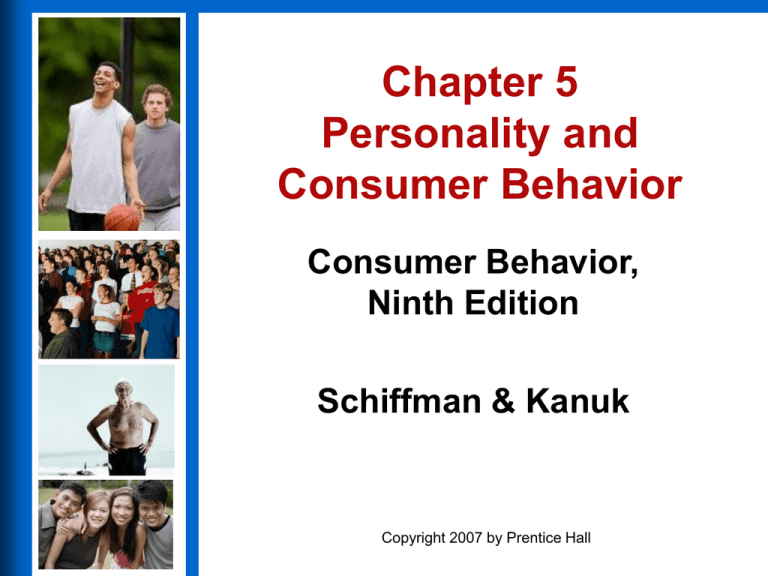Chapter 3 Market Segmentation
advertisement

Chapter 5 Personality and Consumer Behavior Consumer Behavior, Ninth Edition Schiffman & Kanuk Copyright 2007 by Prentice Hall What Is Personality • The inner psychological characteristics that both determine and reflect how a person responds to his or her environment Copyright 2007 by Prentice Hall 5-3 The Nature of Personality • Personality reflects individual differences • Personality is consistent and enduring • Personality can change Copyright 2007 by Prentice Hall 5-5 Discussion Questions • How would you describe your personality? • How does it influence products that you purchase? Copyright 2007 by Prentice Hall 5-6 Theories of Personality • Freudian theory – Unconscious needs or drives are at the heart of human motivation • Neo-Freudian personality theory – Social relationships are fundamental to the formation and development of personality • Trait theory – Quantitative approach to personality as a set of psychological traits Copyright 2007 by Prentice Hall 5-7 Freudian Theory • Id – Warehouse of primitive or instinctual needs for which individual seeks immediate satisfaction • Superego – Individual’s internal expression of society’s moral and ethical codes of conduct • Ego – Individual’s conscious control that balances the demands of the id and superego Copyright 2007 by Prentice Hall 5-8 Figure 5.2 A Representation of the Interrelationships Among the Id, Ego, and Superego Copyright 2007 by Prentice Hall 5 - 10 Freudian Theory and “Product Personality” • Consumer researchers using Freud’s personality theory see consumer purchases as a reflection and extension of the consumer’s own personality Copyright 2007 by Prentice Hall 5 - 11 Table 5.1 Snack Food Personality Traits Potato Chips: Ambitious, successful, high achiever, impatient Tortilla Chips: Perfectionist, high expectations, punctual, conservational Pretzels: Lively, easily bored, flirtatious, intuitive Snack Crackers: Rational, logical, contemplative, shy, prefers time alone Copyright 2007 by Prentice Hall 5 - 12 Neo-Freudian Personality Theory • We seek goals to overcome feelings of inferiority • We continually attempt to establish relationships with others to reduce tensions • Karen Horney was interested in child-parent relationships and desires to conquer feelings of anxiety. Proposed three personality groups – Compliant move toward others, they desire to be loved, wanted, and appreciated – Aggressive move against others – Detached move away from others Copyright 2007 by Prentice Hall 5 - 13 Trait Theory • Personality theory with a focus on psychological characteristics • Trait - any distinguishing, relatively enduring way in which one individual differs from another • Personality is linked to how consumers make their choices or to consumption of a broad product category - not a specific brand Copyright 2007 by Prentice Hall 5 - 14 Trait Theory Consumer Innovators And Noninnovators • • • • • Innovativeness Dogmatism Social character Need for uniqueness Optimum stimulation level • Variety-novelty seeking Copyright 2007 by Prentice Hall • The degree to which consumers are receptive to new products, new services, or new practices 5 - 15 Trait Theory Consumer Innovators And Noninnovators • • • • • Innovativeness Dogmatism Social character Need for uniqueness Optimum stimulation level • Variety-novelty seeking Copyright 2007 by Prentice Hall • A personality trait that reflects the degree of rigidity a person displays toward the unfamiliar and toward information that is contrary to his or her own established beliefs 5 - 16 Trait Theory Consumer Innovators And Noninnovators • • • • • Innovativeness Dogmatism Social character Need for uniqueness Optimum stimulation level • Variety-novelty seeking • Ranges on a continuum for inner-directedness to other-directedness • Inner-directedness – rely on own values when evaluating products – Innovators • Other-directedness – look to others – less likely to be innovators Copyright 2007 by Prentice Hall 5 - 17 Trait Theory Consumer Innovators And Noninnovators • • • • • Innovativeness Dogmatism Social character Need for uniqueness Optimum stimulation level • Variety-novelty seeking Copyright 2007 by Prentice Hall • Consumers who avoid appearing to conform to expectations or standards of others 5 - 18 Table 5.4 Excerpt A Sample Items from a Consumers’ Need for Uniqueness Scale 1. I collect unusual products as a way of telling people I’m different 2. When dressing, I have sometimes dared to be different in ways that others are likely to disapprove 3. When products or brands I like become extremely popular, I lose interest in them 4. As far as I’m concerned, when it comes to the products I buy and the situations in which I use them, custom and rules are made to be broken 5. I have sometimes purchased unusual products or brands as a way to create a more distinctive personal image Copyright 2007 by Prentice Hall 5 - 19 Cognitive Personality Factors • Need for cognition (NC) – A person’s craving for enjoyment of thinking – Individual with high NC more likely to respond to ads rich in product information • Visualizers versus verbalizers – A person’s preference for information presented visually or verbally – Verbalizers prefer written information over graphics and images. Copyright 2007 by Prentice Hall 5 - 22 Discussion Question • How does NC and visualizer/verbalizer affect advertisers? • Which media is best for each group? Copyright 2007 by Prentice Hall 5 - 23 From Consumer Materialism to Compulsive Consumption • Consumer materialism – The extent to which a person is considered “materialistic” • Fixated consumption behavior – Consumers fixated on certain products or categories of products • Compulsive consumption behavior – “Addicted” or “out-of-control” consumers Copyright 2007 by Prentice Hall 5 - 24 Table 5.6 Sample Items to Measure Compulsive Buying 1. When I have money, I cannot help but spend part or the whole of it. 2. I am often impulsive in my buying behavior. 3. As soon as I enter a shopping center, I have an irresistible urge to go into a shop to buy something. 4. I am one of those people who often responds to direct mail offers. 5. I have often bought a product that I did not need, while knowing I had very little money left. Copyright 2007 by Prentice Hall 5 - 25 Consumer Ethnocentrism • Ethnocentric consumers feel it is wrong to purchase foreign-made products • They can be targeted by stressing nationalistic themes Copyright 2007 by Prentice Hall 5 - 26 This ad is designed to appeal to consumer ethnocentrism. Copyright 2007 by Prentice Hall 5 - 27 Brand Personality • Personality-like traits associated with brands • Examples – – – – Purdue and freshness Nike and athlete BMW is performance driven Levi’s 501 jeans are dependable and rugged • Brand personality which is strong and favorable will strengthen a brand but not necessarily demand a price premium Copyright 2007 by Prentice Hall 5 - 29 Discussion Questions • Pick three of your favorite brands. • Describe their personality. Do they have a gender? What personality traits do they have? Copyright 2007 by Prentice Hall 5 - 30 Product Personality Issues • Gender – Often used for brand personalities – Some product perceived as masculine (coffee and toothpaste) while others as feminine (bath soap and shampoo) • Geography – Actual locations like Philadelphia cream cheese and Arizona iced tea – Fictitious names also used such as Hidden Valley and Bear Creek • Color – Color combinations in packaging and products denotes personality Copyright 2007 by Prentice Hall 5 - 32 Marketers often use a fictitious location to help with personality. Copyright 2007 by Prentice Hall 5 - 33 Table 5.10 The Personality-like Associations of Colors BLUE Commands respect, authority •America’s favored color •IBM holds the title to blue •Associated with club soda •Men seek products packaged in blue •Houses painted blue are avoided •Low-calorie, skim milk •Coffee in a blue can perceived as “mild” Caution, novelty, temporary, YELLOW warmth •Eyes register it faster •Coffee in yellow can perceived as “weak” •Stops traffic •Sells a house Secure, natural, relaxed or easyGREEN going, living things •Good work environment •Associated with vegetables and chewing gum •Canada Dry ginger ale sales increased when it changed sugar-free package from red to green and white RED Human, exciting, hot, passionate, strong Powerful, affordable, informal Informal and BROWN relaxed, masculine, nature Goodness, purity, ORANGE •Makes food “smell” better •Coffee in a red can perceived as “rich” •Women have a preference for bluish red •Men have a preference for yellowish red •Coca-Cola “owns” red •Draws attention quickly •Coffee in a dark-brown can was “too strong” •Men seekreduced productscalories packaged in brown •Suggests chastity, cleanliness, •Pure and wholesome food delicacy, •Clean, bath products, feminine refinement, formality Sophistication, •Powerful clothing BLACK power, authority, •High-tech electronics mystery SILVER, Regal, wealthy, •Suggests premium price GOLD stately Copyright 2007 by Prentice Hall WHITE 5 - 35 Self and Self-Image • Consumers have a variety of enduring images of themselves • These images are associated with personality in that individuals consumption relates to self-image Copyright 2007 by Prentice Hall 5 - 37 The Marketing Concept Issues Related to Self and Self-Image • One or multiple selves • Makeup of the self-image • Extended self • Altering the selfimage Copyright 2007 by Prentice Hall • A single consumer will act differently in different situations or with different people • We have a variety of social roles • Marketers can target products to a particular “self” 5 - 39 The Marketing Concept Issues Related to Self and Self-Image • One or multiple selves • Makeup of the self image • Extended self • Altering the selfimage Copyright 2007 by Prentice Hall • Contains traits, skills, habits, possessions, relationships and way of behavior • Developed through background, experience, and interaction with others • Consumers select products congruent with this image 5 - 40 Different Self-Images Actual SelfImage Ideal Self-Image Ideal Social Self-Image Social Self-Image Expected Self-Image Copyright 2007 by Prentice Hall 5 - 41 The Marketing Concept Issues Related to Self and Self-Image • One or multiple selves • Makeup of the self-image • Extended self • Altering the selfimage Copyright 2007 by Prentice Hall • Possessions can extend self in a number of ways: – – – – Actually Symbolically Conferring status or rank Bestowing feelings of immortality – Endowing with magical powers 5 - 42 The Marketing Concept Issues Related to Self and Self-Image • One or multiple selves • Makeup of the self-image • Extended self • Altering the self -image Copyright 2007 by Prentice Hall • Consumers use selfaltering products to express individualism by – Creating new self – Maintaining the existing self – Extending the self – Conforming 5 - 43







